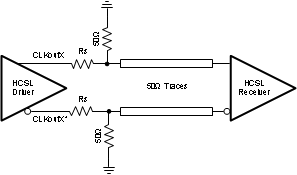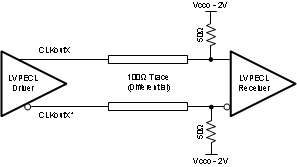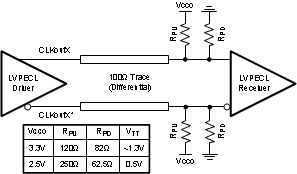SNAS577G February 2012 – August 2018 LMK00304
PRODUCTION DATA.
- 1 Features
- 2 Applications
- 3 Description
- 4 Revision History
- 5 Pin Configuration and Functions
- 6 Specifications
- 7 Parameter Measurement Information
- 8 Detailed Description
- 9 Application and Implementation
- 10Power Supply Recommendations
- 11Device and Documentation Support
- 12Mechanical, Packaging, and Orderable Information
Package Options
Mechanical Data (Package|Pins)
- RTV|32
Thermal pad, mechanical data (Package|Pins)
- RTV|32
Orderable Information
9.3.1 Termination for DC-Coupled Differential Operation
For DC-coupled operation of an LVDS driver, terminate with 100 Ω as close as possible to the LVDS receiver as shown in Figure 29.
 Figure 29. Differential LVDS Operation, DC Coupling,
Figure 29. Differential LVDS Operation, DC Coupling,
No Biasing by the Receiver
For DC-coupled operation of an HCSL driver, terminate with 50 Ω to ground near the driver output as shown in Figure 30. Series resistors, Rs, may be used to limit overshoot due to the fast transient current. Because HCSL drivers require a DC path to ground, AC coupling is not allowed between the output drivers and the 50-Ω termination resistors.
 Figure 30. HCSL Operation, DC Coupling
Figure 30. HCSL Operation, DC Coupling For DC-coupled operation of an LVPECL driver, terminate with 50 Ω to Vcco - 2 V as shown in Figure 31. Alternatively terminate with a Thevenin equivalent circuit as shown in Figure 32 for Vcco (output driver supply voltage) = 3.3 V and 2.5 V. In the Thevenin equivalent circuit, the resistor dividers set the output termination voltage (VTT) to Vcco – 2 V.
 Figure 31. Differential LVPECL Operation, DC Coupling
Figure 31. Differential LVPECL Operation, DC Coupling  Figure 32. Differential LVPECL Operation, DC Coupling, Thevenin Equivalent
Figure 32. Differential LVPECL Operation, DC Coupling, Thevenin Equivalent